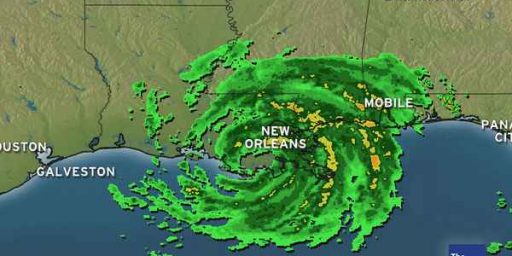Katrina: Man Made Disaster?
Wizbang’s Paul points to this New Orleans Times-Pacayune piece:
Evidence points to man-made disaster
As investigators and residents have picked through the battered New Orleans levee system’s breaches, churned-up soil and bent sheet pile in the 100 days since Hurricane Katrina struck, they have uncovered mounting evidence that human error played a major role in the flood that devastated the city. Floodwall breaches linked to design flaws inundated parts of the city that otherwise would have stayed dry, turning neighborhoods into death traps and causing massive damage. In other areas, poorly engineered gaps and erosion of weak construction materials accelerated and deepened flooding already under way, hampering rescue efforts in the wake of the storm. These problems turned an already deadly disaster into a wider man-made catastrophe and have made rebuilding and resettlement into far tougher and more expensive challenges.
That’s the picture that emerges from investigations of the levee system by teams sponsored by the state government, the American Society of Civil Engineers and the National Science Foundation, as well as from dozens of interviews with local residents, officials and engineers. Experts say the New Orleans flood of 2005 should join the space shuttle explosions and the sinking of the Titanic on history’s list of ill-fated disasters attributable to human mistakes.
The evidence points to critical failures in design and construction, as well as a lack of project oversight and responsibility that allowed small problems to metastasize into fatal errors. Twisted lines of authority led to cursory inspections, communications snafus and even confusion about such basic information as wall dimensions.
[…]
The levee system’s design dates to the 1950s, when understanding of hurricane risks and flood dynamics was primitive compared to today. The system was never built to take a hit from the most powerful hurricanes, storms in Categories 4 or 5 on the Saffir-Simpson scale. The levees were designed by congressional mandate to fend off floodwater heights — up to about 11 or 13 feet, depending on location — that Category 1 or 2, and some Category 3 storms would kick up. But the investigations show that the levees did not live up even to that billing. When Katrina’s storm surge rolled in from the Gulf of Mexico before dawn Aug. 29, the huge dome of water followed a path up the Mississippi River and then along the Mississippi River-Gulf Outlet into Lake Borgne.
[…]
Another factor in the breaches, one with national implications, is the low safety factor used in constructing the levee banks and floodwalls. A safety factor is a kind of cushion that engineers include in a structure’s design to ensure it can withstand all the punishment it’s designed to take, plus a little more. Corps standards for levees and floodwalls date back decades, officials say, and were intended to protect sparsely populated areas, not cities and billions of dollars of infrastructure. The safety factor of 1.3 used in the designs is significantly lower than those used in structures with similarly large-scale tasks of protecting lives and property.
So, the criticism is that we made a mistake by designing a dam in the 1950s using 1950s era know-how and that the Corps of Engineers didn’t factor in a risk factor so high that the levees would never have been built? That strikes me as a ridiculous standard.
Paul adds, “In effect, the New Orleans flood of 2005 was not a hurricane, it was a dam burst.” But we knew that the day of the hurricane, when it passed with comparatively little damage. But the dam didn’t burst in isolation; it did so as a consequence of Hurricane Katrina.
I do agree with Mary Katharine Ham, though, that building a $13 million shrine to the Corps of Engineers with Katrina relief funds might not be such a good idea.
UPDATE: An interesting discussion has broken out in the comments section, which has led to a follow-up post Katrina: Louisiana Levees and Federal Funds





James, you’ve never been further off base.
I’ll explain via an update. (or maybe new post) But in the mean time, please read the link I have about the MSM being strangely silent.
It will explain it a lot more.
For starters James, the main breaks were in floodwalls made in the late 90s. – Less than 10 years ago.
Trust me, you’re in way uncharted territory on this one.
If we’re going to protect at all against natural disasters, we ought to do a reasonable job of it.
As I think was discussed ad nauseam at OTB and elsewhere, there’s absolutely no player in the Katrina disaster who comes off well. The politicians at all levels preferred voter-friendly short-term spending to less glamorous long-term spending.
Anderson:
From your last paragraph in your comment, I assume you mean that the Clinton Administration “prefered voter friendly short term to less glamorous long term spending” They were in power 10 years ago and had authority to insure that tax dollars were spent wisely.
Oh well, another liberal boondoggle.
Clinton, both Bushes, Reagan, Carter … a disaster decades in the making, Herb. And that’s just the White House. Louisiana’s elected officials weren’t exactly banging down the door to get the levees perfected.
>Louisiana’s elected officials weren’t exactly banging down the door to get the levees perfected.
You have disqualified yourself from speaking credibly on this topic.
Our delegation has been trying to do this for years and requests have fallen on deaf ears.
Now over 1000 people are dead, a half a million homeless and a major metropolitan city is in ruins.
Not trying too terribly hard, as JJ points out.
I’m not saying that LA’s pols were more venal and shortsighted than those of other states, in this instance at least. It’s just more fun to spend on bells and whistles than on long-term disaster prevention. “Everyone wants to go to heaven, but nobody wants to die.”